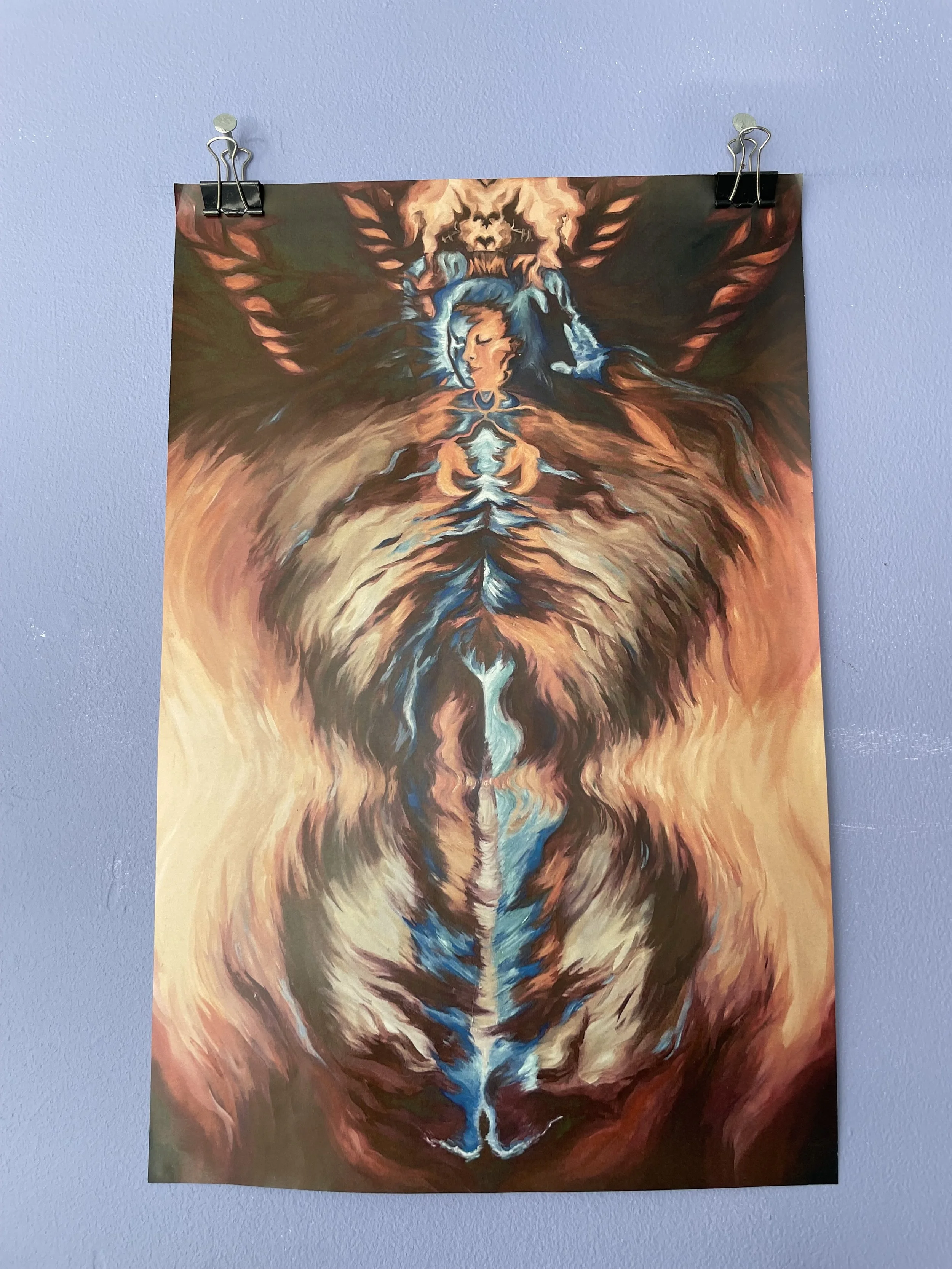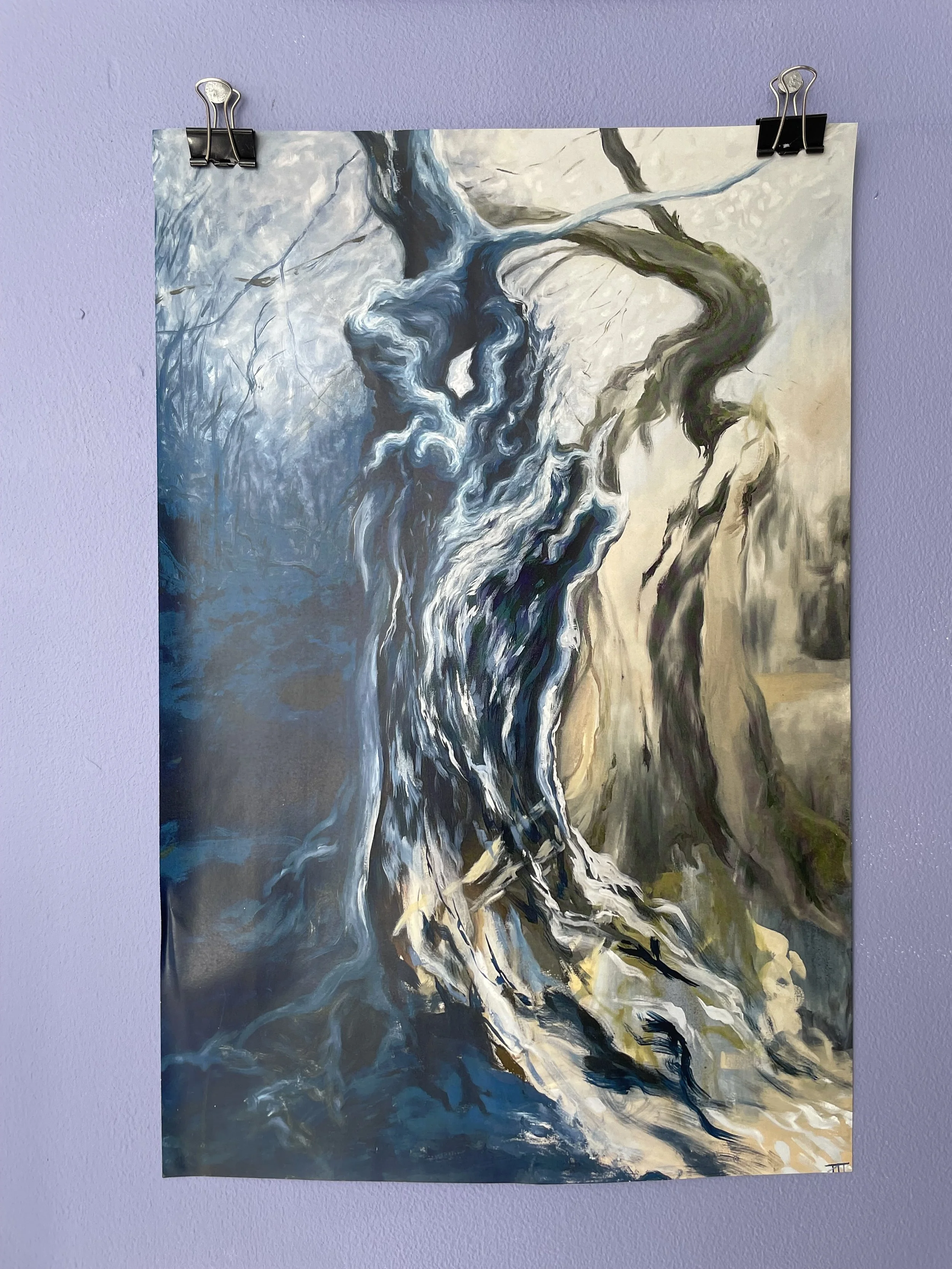Artist Interview with Jenna Tatham
Interview by Emilia Søgaard
Edited by Myfanwy Greene
Speaking with artist Jenna Tatham whose artworks ‘The Empress’ and ‘Decaying Sapling’ are displayed in the exhibition, Unbound: Art of the Mystical and the Magical, at the Norman Rea Gallery we discussed her artistic career, the challenges facing emerging artists and how her artistic practice fits into Unbound.
Installation view, Unbound, Norman Rea Gallery, 2025.
Growing up in Wiltshire, Jenna spoke about how she has been creating since the age of three and how she was inspired to work harder to reach the higher skill level of her older siblings. Flash forward many years, she completed an Art Foundation at the Kingston School of Art, specialising in Fashion. However, Jenna rejected the idea of joining the traditional fashion industry — an industry which she viewed as extremely detrimental to the planet — choosing instead to study at the Charles Cecil Studios in Florence, Italy. The studio is a traditional art atelier, teaching sight-size method, upholding the figurative tradition of life drawing and painting, where Jenna studied portraiture and life size techniques. She explains how useful this atelier was for training her eye and how her artistic practice grew from this realism to undeniably more abstract forms.
Leaving the Charles Cecil Studios she developed the techniques that she’d learnt and applied them in a way which responded to the traditional ideas but in an ultimately more personal way. Jenna developed her work further exhibiting at Il Conventino and then collaborating with Polimoda, a fashion school in Florence on a project with Acquaflor. The collaborative project was centred around the theme of alchemy and she created two large paintings, of masculine and feminine goddesses.
Then, moving back to the UK, Jenna exhibited at different group exhibitions in London and last year had a solo show in London. She comments on the importance of exhibiting her life size paintings which demand being seen in person. She describes them as an ‘energetic mirror’ for the viewer to be able to stand in front of and relate to, and important aspect of the art/audience interaction. She found the space for her solo exhibition on the website Appear Here, which she recommends for young emerging artists to hire out.
Jenna is currently in Florence again, and on our video call she flips the camera and I catch a glimpse of Brunelleschi’s cupola. Given the richness of the artistic heritage in Florence, I ask her how it feels to be an artist in that wonderful city.
Jenna: Being in Florence is endlessly inspiring with beauty everywhere, with each street and every piazza offering sights you’ve not noticed before — there are people creating in all different ways.
A central theme in her work is women immersed in water, and there seems to be a direct correlation between this subject matter and the places she has lived. Jenna spent part of her childhood in Cologne and then lived in Florence, and both cities' topographies are dominated by a river. She talks of the tranquility attained from staring at the river's surface and how each of her artworks is ritualistic; she likens it to a baptism, as she feels she is not the same in herself throughout the process. The women immersed in water as a theme, began in 2022, with her first artwork exploring this being a contemporary rendition of Millais’ ‘Ophelia’. She feels that her painting is about surrendering, allowing her to mutate ideas, playing with the barrier of forms and formlessness.
Jenna Tatham, ‘The Empress’, (artwork print), 2025.
The curators of Unbound describe the exhibitions’ aim to reconfigure the fixed ideas of human identity, by questioning and offering visions where selfhood becomes fluid, interconnected, and untethered. This visual distortion is to encourage the observer to rethink stereotypes of representations of the body and embrace the unknown.
Jenna: My work is a kind of alchemy: the transmutation of a dense energy into something light. Looking at ‘The Empress’ in particular, we see the divine female — based off of the Empress card in the Tarot deck. The form of the main figure is a container of kinds, womb-like, but moving past the corporeal, the feeling of energy that you can feel and sense but it is outside of you.
Jenna uses contrasting tones to represent the simultaneous existence of zones. Similarly to how music can allow you to experience the whole spectrum of emotions, she feels that her paintings have a similar intention. She is developing the surreal aspect of her artworks which encourage multiple interpretations, as exhibiting in different spaces lead to a better understanding of how visitors respond to her artworks which she believes is important.
Asking her about her inspirations she mentions Surrealism, the clear influence of Impressionism, the colours used by Monet — specifically seeing the ‘The Water-Lily Pond’ at the National Gallery — commenting that this grand scale of artworks is an aim of hers.
Jenna Tatham, ‘Decaying Sapling’, (artwork p), 2024.
Talking to Jenna about ‘Decaying Sapling’, she uncovered the multiple layers of the artwork.
There is a map of her body in the woods under the painting, which she then painted over. The tree in the background is a reference to a decayed tree from a forest near to her home in the UK. A tree she has seen standing in the forest, yet no longer living, decaying, yet boasting these brilliant rust colours, dead, yet with brilliant flows and grooves in different directions like the flow of life, or the flow of a river. Jenna painted over her body with another tree — creating two representations of the tree from different perspectives. This painting deals with time as a continuum, of night and day, and shows the progression into abstraction within her own work, leaning into intuition and being more free and curious in the process of creating.
Emilia: What are the challenges of being a young artist?
Jenna: As a young emerging artist, creative collaborations appear to be very exciting. Something I’ve learnt from a lot of creatives around me is to value your time and creativity; to learn not to give it away to non-reciprocal relationships. To learn the practicalities of sustaining yourself through your creativity, being able to balance the want to monetise it and not cageing it. As a young artist you’re still growing and you should not allow yourself to be palatable, doing paintings just for approval.
She expresses how her relationship with her creativity needs to be healthy, likening it to the care and protection of an inner child — necessitating intentional care. Jenna sees art as a healing process, as a freeing act and how she feels at the time of creating is inextricably linked to how her artworks turn out.
Check out Jenna’s websites here:
https://www.jennatathamart.com/
https://www.spiritualarts.org.uk/jenna-tatham-transcendental-art/



